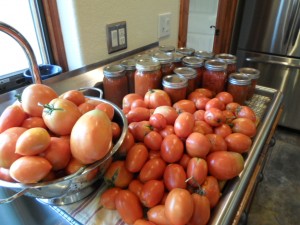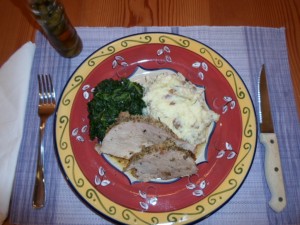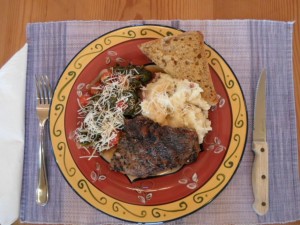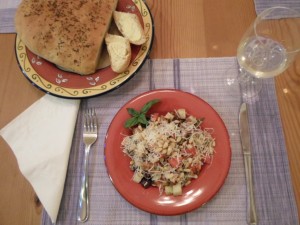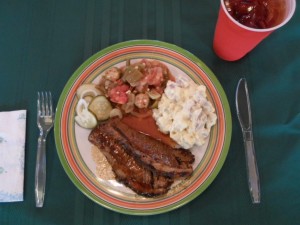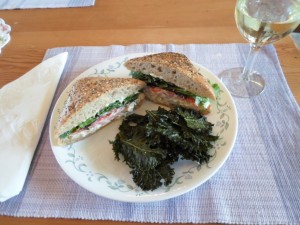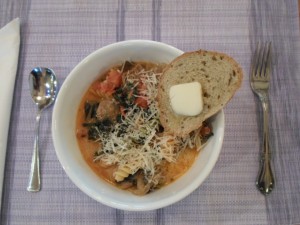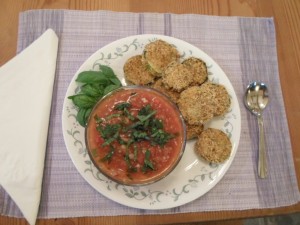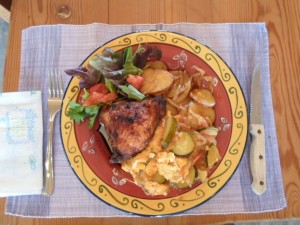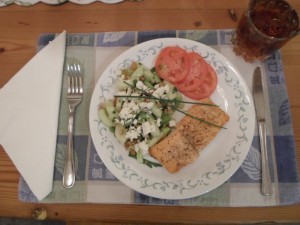Pressure canning is something I have always wanted to do. I’ve pickled vegetables and processed them with the water-bath method, but the ability to preserve food without all the vinegar and salt seemed out of my reach. That is until I purchased a used pressure cooker/canner. What makes it even more interesting to me is that it once belonged to centenarian Hazle Terry. Hopefully, I can do as well with it as she.
So far I’ve processed tomato quarters and hot salsa. Pasta sauce was next on my list. I knew the effort would take a few hours since I needed to remove the tomato skins by boiling them in water and peeling as well as allowing the tomatoes to simmer with onions, garlic and savory herbs before pressure canning.
Since I was going to be in the kitchen heating up the house anyway, I decided to cook the huge pork loin my husband picked up when he offered to get the groceries – it’s been a busy week. I was thinking a small one-pound loin would be nice for a dinner, but like most men – go big or go home – he bought almost four pounds of pig. Actually he did very well; it was a beautiful roast.
While water started to boil for the tomatoes, I set the oven for 350 degrees and seared on the stove-top all six sides of the pork loin – that included the ends. Placing the loin in a roasting pan with the fatty side up, I salted and peppered and spread rosemary pesto all over the top of the loin. (Rosemary pesto is a paste made with rosemary, garlic, walnuts, olive oil, parmesan, salt and pepper. Made up in 4-oz. container portions, it can be frozen and used as needed.) I also sprinkled panko bread crumbs on top of the loin and drizzled it with olive oil. It already smelled good.
Because of its size, that loin was going to need to cook for almost two hours. So into the oven with the timer set for 45 minutes. Then I began processing tomatoes. After 45 minutes, I made a tent with foil and placed it loosely over the roast. This keeps a little moisture in and more importantly, keeps the rosemary pesto from browning too much. Back into the oven and set the timer for another 45 minutes.
By this time the tomatoes have been peeled; onion and garlic have sautéed in a huge pot; the pot has been deglazed with a little red wine; herbs, seasonings and tomatoes have been added; and the sauce is simmering nicely. And I needed to decide what to serve with the loin for dinner. Potatoes or rice came to mind and I decide on potatoes since I still had a few left and rice will keep. I made the smashed potato recipe from last week’s Leader and since I had so much going on, I just popped frozen spinach into the microwave. Both are quick and easy.
After the second set of 45 minutes had passed, I pulled out the loin and checked the internal temperature with a meat thermometer. I was looking for 160 degrees and we weren’t there. I ended up cooking the loin for another 30 minutes before reaching 162 degrees. I let the meat rest for about 20 minutes before slicing.
The rosemary pesto and panko bread crumbs made a flavorful crust over the meat that was moist and perfectly seasoned. The smashed potatoes and spinach paired nicely with this incredible roast. I still need to pressure can the jarred pasta sauce and it looks like we’ll be having pork loin for a few more meals.

